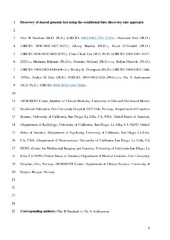Discovery of shared genomic loci using the conditional false discovery rate approach
Smeland, Olav Bjerkehagen; Frei, Oleksandr; Shadrin, Alexey A.; O'Connell, Kevin; Fan, Chun Chieh; Bahrami, Shahram; Holland, Dominic; Djurovic, Srdjan; Thompson, Wesley Kurt; Dale, Anders; Andreassen, Ole Andreas
Peer reviewed, Journal article
Accepted version

Åpne
Permanent lenke
https://hdl.handle.net/1956/21050Utgivelsesdato
2020Metadata
Vis full innførselSamlinger
Sammendrag
In recent years, genome-wide association study (GWAS) sample sizes have become larger, the statistical power has improved and thousands of trait-associated variants have been uncovered, offering new insights into the genetic etiology of complex human traits and disorders. However, a large fraction of the polygenic architecture underlying most complex phenotypes still remains undetected. We here review the conditional false discovery rate (condFDR) method, a model-free strategy for analysis of GWAS summary data, which has improved yield of existing GWAS and provided novel findings of genetic overlap between a wide range of complex human phenotypes, including psychiatric, cardiovascular, and neurological disorders, as well as psychological and cognitive traits. The condFDR method was inspired by Empirical Bayes approaches and leverages auxiliary genetic information to improve statistical power for discovery of single-nucleotide polymorphisms (SNPs). The cross-trait condFDR strategy analyses separate GWAS data, and leverages overlapping SNP associations, i.e., cross-trait enrichment, to increase discovery of trait-associated SNPs. The extension of the condFDR approach to conjunctional FDR (conjFDR) identifies shared genomic loci between two phenotypes. The conjFDR approach allows for detection of shared genomic associations irrespective of the genetic correlation between the phenotypes, often revealing a mixture of antagonistic and agonistic directional effects among the shared loci. This review provides a methodological comparison between condFDR and other relevant cross-trait analytical tools and demonstrates how condFDR analysis may provide novel insights into the genetic relationship between complex phenotypes.